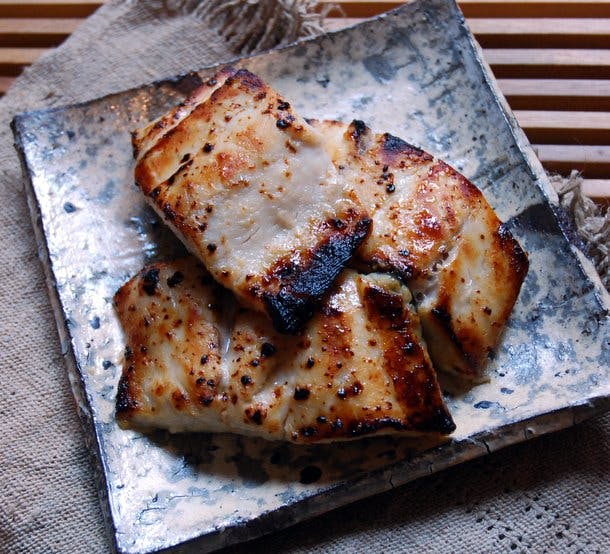
sakekasu-cured grilled fish
Discover the art of using sakekasu, the 'lees' of sake, to marinate and flavor fish in Japanese cuisine. Learn about the traditional method, the chef's recommendations, and step-by-step instructions for preparing delicious glazed black cod at home.
I became interested in sakekasu (or sake kasu) at Matsuri, the restaurant where I volunteer as a cook. Chef Ono prepares his delicious version of glazed black cod by first marinating the fish for several days in a mixture that includes sakekasu. I wondered about the effect of this ingredient. But before I get into this, let me pause for a quick definition:
Sakekasu is the "lees" of sake. To brew sake, rice, yeast and koji mold is fermented in a tank (a vast oversimplification, of course; read more about sake brewing here). Once this rice mash is ready, it's pressed and filtered to squeeze out the liquid -- the sake. The leftovers are the lees, or sakekasu. These lees, which are formed into off-white colored cakes or sheets, are packed with sake flavor and alive with bacteria and yeast. They're used for cooking and pickling and are even grilled as a snack.
Okay, back to Matsuri. I asked the chef about his glazed fish. He explained that the sakekasu not only flavors the fish, but acts to preserve it. But before he marinates, he first salts the fish and lets it sit overnight. Why? "Salt absorbs water from the fish so the flavor becomes more concentrated," he said. "The flesh is like a sponge. Once salt pulls the water out, there's space for something else to get in. So when you marinate it, the marinade gets absorbed into the flesh."
The chef lets the fish marinate in the sakekasu mixture for four or five days, to give the flesh time to fully absorb all the flavors. Once ready, the fish has actually been pickled to a degree. So it can stay in the refrigerator for several more days without spoiling, which speaks to the practical origins of this technique.
I brought home a container of sakekasu from my last visit to Japan and decided to try preparing fish with it at home. (You can find sakekasu in Japanese specialty food shops like the Mitsuwa supermarkets.) Here's the method I followed, which is quite straightforward and simple:
Begin by salting fish and letting it sit overnight. The following day, rinse off the salt in running water, pat the fish dry, slice into individual servings and set aside. In a mixing bowl, combine a cup of sakekasu with a tablespoon or two of sake to make a paste the consistency of thick yogurt. Coat the fish with this marinade -- make sure to slather liberally -- and arrange in a deep dish. Cover with plastic wrap and stick in the fridge for three days.
When you're ready to cook, preheat an oven broiler. Wipe off excess marinade and arrange filets in a lightly-oiled pan. (You don't need a coating of the marinade since the flavors have been already absorbed into the flesh. Also, the marinade will burn under the flames) Pop the fish into the broiler. I cooked my inch-thick fillets for five minutes, but you should adjust depending on the thickness of your fish. Plate and serve -- that's it.
(By the way, instead of a pan I always use a "sizzle plate" for broiling (see picture below), which has a thick aluminum bottom that seriously conducts heat. You can find one at a restaurant supply shop.)
The finished cod was beautifully caramelized and had a distinct and delicious sake flavor and fragrance. The flesh had an interesting and appealing texture, too -- the salting and curing made it much denser. You can use this technique with white-fleshed ocean fish as well as salmon. In addition, once you've marinated the fish, you can freeze it for later use. Just defrost and broil.
I asked Chef Ono about the best fish for this method and he recommends Spanish Mackerel, Black Cod, Salmon, Tile Fish and Red Snapper and other red-skinned fish.
